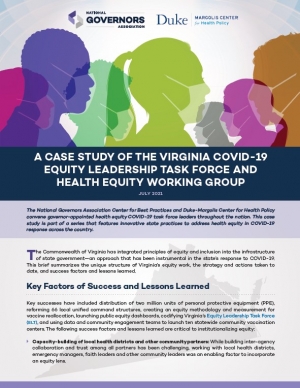
Case Study
A Case Study of the Virginia COVID-19 Equity Leadership Task Force and Health Equity Working Group
The Commonwealth of Virginia has integrated principles of equity and inclusion into the infrastructure of state government—an approach that has been instrumental in the state’s response to COVID-19. This brief summarizes the unique structure of Virginia’s equity work, the strategy and actions taken to date, and success factors and lessons learned.
Key Factors of Success and Lessons Learned
Key successes have included distribution of two million units of personal protective equipment (PPE),reforming 66 local unified command structures, creating an equity methodology and measurement for vaccine reallocation, launching public equity dashboards, codifying Virginia’s Equity Leadership Task Force (ELT), and using data and community engagement teams to launch ten statewide community vaccination centers. The following success factors and lessons learned are critical to institutionalizing equity:
- Capacity-building of local health districts and other community partners: While building inter-agency collaboration and trust among all partners has been challenging, working with local health districts, emergency managers, faith leaders and other community leaders was an enabling factor to incorporate an equity lens.
- Equity work requires a long-term commitment: Collaborations with community vaccination centers (CVCs) and community engagement teams took time to achieve impact. However, after time and investment, CVCs and community engagement teams increased vaccine uptake among the African American, Latino and low-income communities. Due to the successful implementation of community engagement, Virginia plans to replicate this approach through local health departments. Federal funds will be used to hire local individuals for the community engagement teams as full-time community health outreach workers.
- Apply a data-driven approach: The ELT built public-private partnerships and integrated community feedback sessions to define “equity” and “vulnerable populations.” As of March 2021, the ELT began submitting a monthly state-mandated equity report to the Virginia General Assembly. This report documents the equity related successes and lessons learned. Community feedback sessions have been crucial to determine locations for community vaccination events and the design of PPE pilots. Lastly, the ELT is adopting a data-driven equity lens on public health and emergency management by embedding equity into the language of emergency management planning grants and planning for vaccine distribution.
- Focus on governance and procedural equity: State governments can institutionalize equity across agencies and integrate an equity lens into the structure of government. Virginia established the cabinet-level Chief Diversity, Equity, and Inclusion Officer, the ELT, and the Health Equity Working Group (HEWG) to sustain the work of the ELT during and beyond the COVID-19 crisis. The ELT encouraged the use of equity targets to hold local health districts accountable for serving communities most marginalized and underrepresented. Lastly, the ELT learned that governance and procedural processes are foundational in the consistent prioritization of equity, especially given the long-standing structural inequity in systems of government, public health and emergency management.
- Sharing data to create accountability and build trust with community members: The ELT has prioritized sharing data including COVID-19 related health disparities and continuing gaps in service provision with local partners, constituents and state agencies. The ELT has used data to highlight the systemic nature of racial inequity (e.g., by overlaying historically redlined localities with demographic, social determinant of health, and elevated health risk data). Data-sharing facilitates measuring progress, centers opportunities for action, and confronts the uncomfortable truth of the way the structural creation of an inherently inequitable system of laws and systems contributed to present day disparities. Lastly, the ELT launched the first public-facing equity dashboards related to COVID-19 response and recovery programs.
- Demonstrating ‘return on investment’ for racial equity is a gradual and long-term process: The remnants of structural racism in Virginia (and nationwide) still have a significant impact on health inequities, despite efforts in recent decades to remedy these disparities. As a result, no quick fixes exist. Governance and procedural equity must be intentional, transparent and incorporated into the systems of public health, emergency management, and state government more broadly. A ‘return on investment’ for equity-related interventions and long-term reform will take time to emerge. Leaders will need to incorporate their role and commitment in addressing racism across all sectors to their response to the larger public health crisis.
